The concept of the SAID principle—Specific Adaptation to Imposed Demands—lies at the heart of why the human body becomes stronger, faster, more resilient, or more coordinated when exposed to a particular stimulus. While the principle itself is succinct, its practical application demands a nuanced understanding of how various stressors interact with the body’s adaptive machinery, how those adaptations evolve over time, and how they can be harnessed to translate laboratory‑level changes into real‑world performance. This article unpacks the SAID principle from a mechanistic standpoint, outlines a systematic approach for applying it in training environments, and provides concrete examples that illustrate the pathway from imposed demand to measurable performance gain.
Understanding the Core Concept of SAID
At its essence, the SAID principle states that the body will adapt specifically to the type, magnitude, and pattern of stress placed upon it. This specificity is not a vague notion of “training the body”; rather, it reflects a precise biological response where cellular, tissue, and systemic changes are directed toward handling the exact demands encountered. The principle can be broken down into three interrelated components:
- Imposed Demand – The external stimulus (e.g., a heavy squat, a high‑intensity interval, a prolonged stretch) that challenges a particular physiological system.
- Specific Adaptation – The resultant structural or functional change that improves the system’s capacity to meet that demand (e.g., increased myofibrillar density, enhanced mitochondrial oxidative capacity, altered connective tissue compliance).
- Performance Transfer – The degree to which the adaptation improves actual task execution, whether in sport, occupational tasks, or daily activities.
Understanding these components clarifies why a program that emphasizes maximal strength will not automatically improve sprint speed, and why a regimen focused on aerobic endurance will not directly increase maximal power output.
Physiological Mechanisms Underlying Specific Adaptations
The body’s response to an imposed demand is mediated through a cascade of molecular and cellular events that differ according to the nature of the stimulus.
| Stimulus Type | Primary Cellular Pathways | Resulting Tissue Changes |
|---|---|---|
| Mechanical Load (e.g., resistance training) | mTOR signaling, satellite cell activation, mechanotransduction via integrins | Hypertrophy of type II fibers, increased cross‑sectional area, reinforced tendon collagen |
| Metabolic Stress (e.g., high‑intensity intervals) | AMPK activation, PGC‑1α up‑regulation, glycolytic enzyme adaptation | Elevated mitochondrial density, improved oxidative phosphorylation, enhanced lactate clearance |
| Neural Demand (e.g., plyometrics, rapid force production) | Increased motor unit recruitment, synaptic plasticity, cortical excitability | Faster rate of force development, improved inter‑muscular coordination, refined proprioceptive feedback |
| Stretch/Lengthening (e.g., flexibility work) | Modulation of fibroblast activity, altered collagen cross‑linking | Increased muscle‑tendon unit compliance, expanded range of motion, reduced passive stiffness |
These pathways illustrate that the body does not respond with a generic “strengthening” signal; rather, it tailors its response to the precise nature of the stressor. The magnitude of the response is also dose‑dependent, following a classic hormetic curve where insufficient stimulus yields negligible adaptation, while excessive stimulus can trigger maladaptive outcomes such as overtraining or injury.
Types of Imposed Demands and Their Distinct Pathways
To apply the SAID principle effectively, practitioners must first categorize the demands they intend to impose. Four broad categories capture most training contexts:
- Force‑Dominant Demands – Emphasize maximal or sub‑maximal force production (e.g., heavy lifts, isometric holds). Adaptations focus on muscle fiber hypertrophy, tendon stiffness, and neural drive.
- Velocity‑Dominant Demands – Prioritize rapid force generation and movement speed (e.g., sprint drills, ballistic throws). Adaptations center on motor unit firing rates, type II fiber recruitment, and neuromuscular synchronization.
- Endurance‑Dominant Demands – Target sustained sub‑maximal effort (e.g., long‑duration cycling, steady‑state rowing). Adaptations involve mitochondrial biogenesis, capillary density, and substrate utilization efficiency.
- Flexibility‑Dominant Demands – Stress the range of motion and tissue extensibility (e.g., static stretching, yoga). Adaptations revolve around collagen remodeling, viscoelastic property changes, and altered stretch tolerance.
Each category engages distinct molecular cascades, and the training stimulus must be crafted to activate the appropriate cascade without inadvertently triggering competing adaptations. For instance, excessive high‑load strength work can increase tendon stiffness, which may be counterproductive for athletes whose sport demands high joint mobility.
Designing Training Stimuli to Align with Desired Performance Outcomes
When translating the SAID principle into a program, the following systematic workflow can be employed:
- Define the Target Performance Metric
- Identify the specific movement, force vector, or energy system that underpins the desired outcome (e.g., vertical jump height, 5‑km time trial, overhead press one‑rep max).
- Map the Underlying Physiological Requirements
- Break down the performance into its constituent components: peak force, rate of force development, aerobic capacity, joint range, etc.
- Select the Imposed Demand that Mirrors Those Requirements
- Choose exercises, loads, and movement patterns that replicate the mechanical, metabolic, and neural characteristics of the target task.
- Quantify the Stimulus Parameters
- Determine load magnitude, contraction velocity, metabolic intensity, and stretch amplitude. These parameters should be expressed in objective units (e.g., %1RM, meters per second, VO₂max percentage, degrees of stretch).
- Implement a Structured Exposure Schedule
- Plan the frequency and duration of each stimulus block to ensure sufficient exposure while allowing for recovery (the recovery aspect will be addressed indirectly through monitoring).
- Monitor Acute Responses
- Use tools such as heart‑rate variability, perceived exertion scales, or neuromuscular performance tests to gauge immediate stress and adjust the stimulus accordingly.
- Evaluate Adaptation Progression
- Periodically reassess the target performance metric and related physiological markers (e.g., muscle thickness via ultrasound, mitochondrial enzyme activity via muscle biopsy, tendon stiffness via elastography).
By adhering to this workflow, the training stimulus remains tightly coupled to the performance goal, ensuring that adaptations are not only specific but also functional.
Progression Strategies Within the SAID Framework
Adaptation is a dynamic process; as the body becomes more efficient at handling a given demand, the stimulus must evolve to continue driving change. Progression within the SAID context can be approached through three primary axes:
- Magnitude Progression – Incrementally increase the absolute load, speed, or stretch intensity. For example, moving from a 70 % 1RM squat to 85 % 1RM over several weeks.
- Complexity Progression – Introduce more sport‑specific movement patterns or multi‑joint coordination demands. A simple knee extension can evolve into a full squat‑to‑press with a unilateral load.
- Variability Progression – Manipulate the stimulus pattern (e.g., altering set/rep schemes, introducing eccentric overload, or varying rest intervals) to prevent accommodation and stimulate novel adaptations.
A practical rule of thumb is to adjust only one axis at a time, allowing clear attribution of subsequent performance changes to the specific modification. This disciplined approach minimizes confounding variables and preserves the specificity of the adaptation.
Assessment and Feedback Loops for Adaptive Tuning
Effective application of the SAID principle hinges on continuous feedback. Two complementary assessment tiers are recommended:
- Macro‑Level Performance Testing
Conduct sport‑specific or functional tests that directly reflect the target outcome (e.g., timed sprints, maximal power output on a force plate). These tests provide a holistic view of whether the imposed demands are translating into performance gains.
- Micro‑Level Physiological Monitoring
Employ targeted measures that capture the underlying adaptations:
- Muscle architecture via ultrasound (fascicle length, pennation angle) for strength‑dominant programs.
- Mitochondrial respiration assays or near‑infrared spectroscopy for endurance‑dominant programs.
- Tendon stiffness via shear‑wave elastography for flexibility‑dominant programs.
Data from these assessments should feed back into the stimulus design step, prompting adjustments in magnitude, complexity, or variability. A closed‑loop system ensures that training remains aligned with the evolving capacity of the athlete.
Translating Adaptations into Competitive Performance
The ultimate test of the SAID principle is whether laboratory‑derived adaptations improve real‑world execution. Bridging this gap involves:
- Contextual Integration – Embedding the adapted movement patterns within the sport’s tactical environment (e.g., practicing a newly strengthened vertical jump within a basketball game scenario rather than in isolation).
- Transfer Drills – Designing drills that mimic competition constraints while preserving the specific stimulus characteristics (e.g., sprinting with a weighted sled to maintain force production while adding sport‑specific speed demands).
- Psychological Reinforcement – Reinforcing confidence in the newly acquired capacity through visualization and cueing, which can enhance motor unit recruitment during competition.
When these steps are systematically applied, the specific adaptations become functional tools that athletes can deploy under pressure, thereby completing the adaptation‑to‑performance continuum.
Common Misconceptions and Pitfalls
| Misconception | Why It’s Problematic | Correct Perspective |
|---|---|---|
| “Any heavy load will improve strength for all movements.” | Ignores directional, velocity, and joint‑angle specificity; may lead to strength that does not transfer. | Load must be applied in the same movement plane, speed, and joint configuration as the target task. |
| “More stimulus always equals more adaptation.” | Overlooks the hormetic response curve; excessive stress can trigger catabolic pathways and injury. | Identify the optimal stress window for each individual and respect the need for recovery. |
| “Specificity equals isolation.” | Believes that only single‑joint, isolated exercises are specific, neglecting the integrated nature of most performance tasks. | Specificity is about the characteristics of the demand, not the isolation of muscles. Multi‑joint, sport‑specific drills can be highly specific. |
| “Adaptations are permanent once achieved.” | Fails to recognize the principle of reversibility; adaptations regress without continued stimulus. | Maintain a baseline level of the specific demand to preserve adaptations, adjusting intensity as needed. |
Awareness of these pitfalls helps practitioners design more effective, evidence‑based programs.
Integrating SAID with Complementary Training Variables
While the SAID principle is the central driver of specificity, it does not operate in isolation. Other training variables—such as load distribution, rest intervals, and environmental conditions—modulate the magnitude and quality of the adaptation. A balanced integration looks like this:
- Load Distribution – Align the distribution of force across the movement with the target task (e.g., front‑loaded versus back‑loaded squats for athletes who need anterior chain dominance).
- Rest Intervals – Tailor inter‑set recovery to the metabolic pathway being stressed; shorter rests favor glycolytic adaptations, longer rests preserve maximal force output.
- Environmental Context – Replicate temperature, altitude, or surface characteristics when the performance environment deviates from the training setting (e.g., sand training for beach volleyball players).
By consciously aligning these variables with the imposed demand, the SAID principle is reinforced rather than diluted.
Practical Case Studies Across Different Modalities
1. Powerlifting – Maximizing Deadlift Performance
- Target Metric: One‑rep max deadlift.
- Imposed Demand: High‑load, low‑velocity pulling with a conventional stance.
- Progression:
- Week 1–2: 70 % 1RM, 4 × 5 reps (magnitude progression).
- Week 3–4: 80 % 1RM, 5 × 3 reps (magnitude progression).
- Week 5–6: Introduce deficit deadlifts (complexity progression) at 75 % 1RM.
- Assessment: Weekly 1RM testing, tendon stiffness via elastography, and bar‑path analysis with motion capture.
- Outcome: Improved force production at the lockout phase, reflected in a 7 % increase in 1RM and reduced bar‑path deviation.
2. Middle‑Distance Running – Enhancing 1500 m Time
- Target Metric: 1500 m race time.
- Imposed Demand: Repeated high‑intensity intervals at 95 % VO₂max with a focus on maintaining stride length.
- Progression:
- Phase 1 (2 weeks): 4 × 800 m at 90 % VO₂max, 3 min rest.
- Phase 2 (2 weeks): 5 × 800 m at 95 % VO₂max, 2 min rest (magnitude progression).
- Phase 3 (2 weeks): 6 × 800 m with slight downhill segments to simulate race terrain (variability progression).
- Assessment: VO₂max testing, lactate threshold, and running economy via treadmill metabolic cart.
- Outcome: 3 % reduction in 1500 m time, accompanied by a 5 % increase in VO₂max and improved running economy.
3. Gymnastics – Expanding Split Flexibility
- Target Metric: Passive split angle (degrees).
- Imposed Demand: Daily static stretch at end‑range with proprioceptive neuromuscular facilitation (PNF) techniques.
- Progression:
- Week 1–2: 30 s hold, 3 × per side (baseline).
- Week 3–4: 45 s hold, 4 × per side (magnitude progression).
- Week 5–6: Add dynamic “kick‑through” movements before static hold (complexity progression).
- Assessment: Goniometric measurement of hip flexion/extension, ultrasound of hamstring fascicle length.
- Outcome: Average increase of 12° in split angle, with measurable elongation of hamstring fascicles.
These case studies illustrate how the SAID principle can be operationalized across strength, endurance, and flexibility domains, each with distinct stimulus characteristics and assessment strategies.
Future Directions and Emerging Research
The SAID principle continues to evolve as new technologies and scientific insights emerge:
- Molecular Profiling – High‑throughput transcriptomics and proteomics are enabling real‑time tracking of gene expression changes in response to specific training stimuli, allowing for ultra‑personalized dose adjustments.
- Neuromechanics Integration – Combining electromyography with motion capture and force plate data provides a holistic view of how neural drive and biomechanics co‑adapt to imposed demands.
- Artificial Intelligence‑Driven Programming – Machine‑learning algorithms can analyze large datasets of training logs and performance outcomes to predict the optimal progression pathway for a given athlete, respecting the SAID constraints.
- Hybrid Training Environments – Virtual‑reality and augmented‑reality platforms are being used to simulate sport‑specific demands while precisely controlling stimulus parameters, offering a new frontier for SAID‑based training.
As these tools mature, the capacity to fine‑tune imposed demands to an unprecedented degree will likely enhance the efficiency and effectiveness of training programs across all levels of sport and health.
In summary, the SAID principle provides a robust, scientifically grounded framework for ensuring that the body’s adaptations are directly relevant to the performance tasks we aim to improve. By dissecting the nature of imposed demands, aligning them with the underlying physiological pathways, and employing systematic progression, assessment, and feedback, practitioners can move beyond generic “train hard” prescriptions toward truly targeted, performance‑driving interventions. The result is a training ecosystem where every rep, interval, or stretch is a purposeful step on the pathway from specific adaptation to measurable performance excellence.





